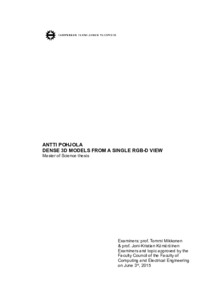Dense 3D Models From a Single RGB-D View
Pohjola, Antti Einari (2016)
Pohjola, Antti Einari
2016
Tietotekniikan koulutusohjelma
Tieto- ja sähkötekniikan tiedekunta - Faculty of Computing and Electrical Engineering
This publication is copyrighted. You may download, display and print it for Your own personal use. Commercial use is prohibited.
Hyväksymispäivämäärä
2016-02-03
Julkaisun pysyvä osoite on
https://urn.fi/URN:NBN:fi:tty-201601221017
https://urn.fi/URN:NBN:fi:tty-201601221017
Tiivistelmä
The increase in processing power of modern computers and mobile devices has enabled the use of three-dimensional (3D) visual data with a nearly realistic level of detail in various applications. This development combined with an increasing interest in technologies such as Virtual Reality and 3D printing has created a need for 3D data acquired from real-life scenarios.
The aim of this work is to examine hardware and software needed to create a 3D model from a simple real-life scenario, and to produce a tool that can perform all the necessary processing steps. The goal is to use affordable hardware and open source software supported by multiple platforms. In this work the Microsoft Kinect is used to capture a Point Cloud representation of various scenarios and objects. This Point Cloud data is improved with multiple processing algorithms and reconstructed as a 3D model with different Surface Reconstruction methods. The results are evaluated by the processing time needed and the quality and usability of the virtual 3D model.
There is a lot of interest and research on the subject so finding tools and methods is not a problem, but selecting those most suitable can be difficult. We find out that there are multiple affordable hardware systems in the market and they are supported by a wide selection of open source software. The methods for Point Cloud processing and Surface Reconstruction are also numerous and well investigated. The Kinect was selected to be used with the Point Cloud Library (PCL) software which had ready implementations for all needed methods and algorithms. The results show that it is possible to use these affordable tools to generate dense 3D models from a single RGB-D view. Some environment decisions, such as using Windows instead of Linux, caused some compatibility issues with the libraries used and the selected methods do not work on all real-life surfaces. The Command Line Interface (CLI) software produced in this work requires further development to be more usable, such as better exception handling and a Graphical User Interface (GUI), but it functions well as a proof-of-concept. The results show that a good quality outcome is achievable with reasonable processing time, but getting the best outcome does require some prior knowledge of the theories behind the methods.
The aim of this work is to examine hardware and software needed to create a 3D model from a simple real-life scenario, and to produce a tool that can perform all the necessary processing steps. The goal is to use affordable hardware and open source software supported by multiple platforms. In this work the Microsoft Kinect is used to capture a Point Cloud representation of various scenarios and objects. This Point Cloud data is improved with multiple processing algorithms and reconstructed as a 3D model with different Surface Reconstruction methods. The results are evaluated by the processing time needed and the quality and usability of the virtual 3D model.
There is a lot of interest and research on the subject so finding tools and methods is not a problem, but selecting those most suitable can be difficult. We find out that there are multiple affordable hardware systems in the market and they are supported by a wide selection of open source software. The methods for Point Cloud processing and Surface Reconstruction are also numerous and well investigated. The Kinect was selected to be used with the Point Cloud Library (PCL) software which had ready implementations for all needed methods and algorithms. The results show that it is possible to use these affordable tools to generate dense 3D models from a single RGB-D view. Some environment decisions, such as using Windows instead of Linux, caused some compatibility issues with the libraries used and the selected methods do not work on all real-life surfaces. The Command Line Interface (CLI) software produced in this work requires further development to be more usable, such as better exception handling and a Graphical User Interface (GUI), but it functions well as a proof-of-concept. The results show that a good quality outcome is achievable with reasonable processing time, but getting the best outcome does require some prior knowledge of the theories behind the methods.
